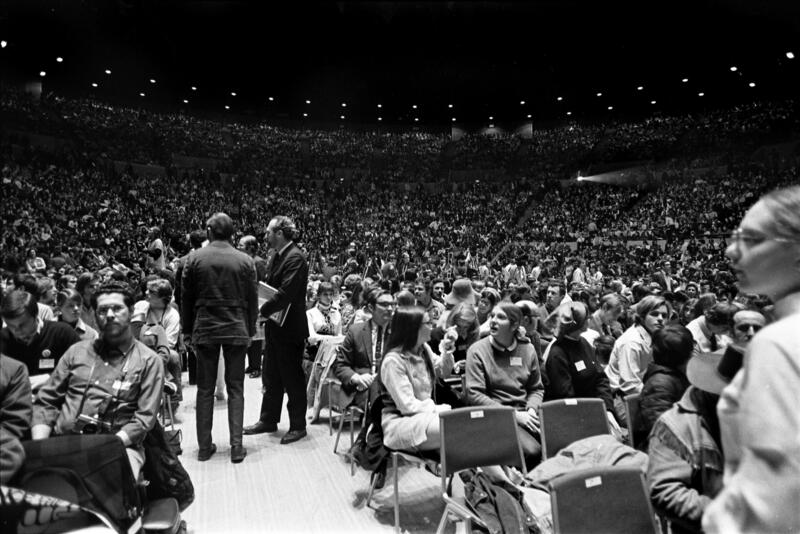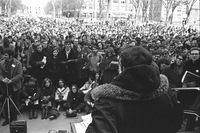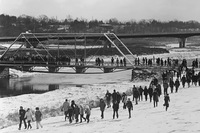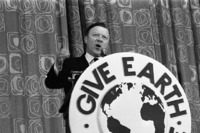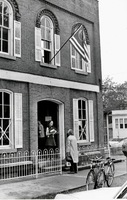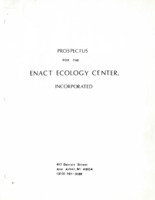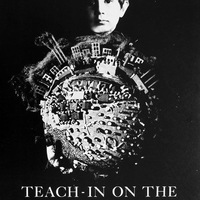See a related article from the Ecology Center's website, From Earth Day to Ecology Center: One of 50 stories, from 50 years of action
Building a Movement
The Ecology Center of Ann Arbor began with a simple idea in 1970. As the environmental movement caught speed across America, college students at the University of Michigan decided to band together and bring environmental awareness to both the student body and the public in the form of a Teach-In. Graduate students in the sciences formed the campus organization Environmental Action for Survival (ENACT) in October 1969, and the members spent the next seven months organizing a Teach-In on the Environment. Through dozens of seminars, demonstrations, and speeches over the course of four days in March 1970, scientists, politicians, and activists outlined the root causes of the environmental crisis. Though their messages differed, all urged the 35,000 attendees to take action, to “Give Earth a Chance.” The Teach-In served as a model for the first Earth Day, celebrated nationally on April 22, 1970. (For the full story of the 1970 Teach-In on the Environment, please visit the companion exhibit "Give Earth a Chance: Environmental Activism in Michigan.")
The student leaders of ENACT wanted the lessons of the Teach-In to be heard for decades to come. They wanted to change the lifestyles of a generation of people and to encourage others to consider their relationship to the environment in their daily lives. A Teach-In was not enough to accomplish this goal; it could merely initiate the momentum.
In this video, ENACT co-founder Dave Allan and treasurer Art Hanson describe what they believed was the best way to carry on the legacy of the Teach-In. Across the nation, people mobilized by the first Earth Day had begun establishing ecology centers in their communities. These organizations hoped to channel environmental concerns into action through education. Using the Ecology Center already established in Berkeley, California as a model, ENACT laid the groundwork for an ecology center in Ann Arbor.
As seen in the ENACT Ecology Center Prospectus, ENACT’s goal was to "bridge the gap between campus, high schools, and community," and to create a center that would educate the people to the best of their abilities. Although the prospectus highlights the struggles to come like funding, it remains optimistic about the future. ENACT knew the Ecology Center would not only help the Ann Arbor community but also act as a model for future ecology centers to come across the country. Ultimately, they hoped to create a national community of environmentally forward-thinking people. They describe their mission in this way:
“Resolving the critical question of the probability of human survival on the planet earth is difficult, impossible without community awareness, concern, and action. It is to this end that the Center provides a framework in which citizens may discuss and obtain information on the pressing ecological issues, and the actions needed to protect their environment and the quality of their lives. The Ecology Center through education programs and a network of information exchange will hopefully evolve action which will prevent the further misuses of the environment and encourage the wise use of all our resources.”
The Ecology Center officially opened in May 1970. Using $10,000 left over from the Teach-In, the Ecology Center was able to get on its feet. After the U-M semester ended, many members of the ENACT Steering Committee left the city to pursue new careers in environmental advocacy. But some stayed, including Elizabeth Grant-Kingwill, a graduate student in the U-M School of Natural Resources.
In this interview from November 2017, Kingwill describes learning to start a non-profit and signing the lease for the Ecology Center’s first headquarters at 417 Detroit St, “a weird little building on a corner.” As the Ann Arbor Observer noted in 1990, the location was unusual but “met [ENACT’s] primary objectives of being accessible to the general public and far enough from the U-M to establish it as a community group.” The Ecology Center called 417 Detroit St home for more than twenty years.
Despite distancing itself physically from the University of Michigan, the Ecology Center benefited from its close relationships with U-M students, faculty, and organizations. To remain a non-profit, the Ecology Center could not engage in overtly political activities. As a result, it was decided that ENACT would become the Center’s political wing. Many students in the School of Natural Resources worked for the Ecology Center, and this relationship allowed the two organizations to collaborate on many environmental research projects and community events.
George Coling, who was on the ENACT Teach-In Steering Committee and became a founding member of the Ecology Center, remarks how important collaboration was to the growing “ecology center movement,” not only with institutions like the University of Michigan but also with ecology centers around the country. In late 1970, Coling left Ann Arbor to work in Washington D.C. where he became the head of the Ecology Center Communications Council. There, he helped ecology centers around the country share information and strategies.
In Ann Arbor, the Ecology Center became a space for environmental organizations to work and share resources. In its first year, the office at 417 Detroit Street also held the offices for ENACT and local chapters of Zero Population Growth and the Sierra Club. In this way, the Ecology Center became a hub that connected newer, more radical environmental organizations to established conservation organizations, creating a network of people committed to environmental change.
Under the leadership of the Ecology Center’s first director William Kopper, the staff began making plans for their first year. Among their most ambitious plans included launching a community glass recycling center, piloting a community organic gardening program, distributing a newsletter, and compiling an environmental library. These larger programs were supplemented with smaller educational events and fundraisers to establish the Ecology Center’s identity in the community. With well-attended environmental movie nights, river clean-up days, bike-a-thons, and seminars on topics ranging from organic farming to mass transportation planning, the Ecology Center taught Ann Arborites about the role they could all play in making their communities healthier and more beautiful places. In the decades to come, the Ecology Center would become a leader in environmental education and advocacy in Ann Arbor and the state of Michigan, nurturing the seeds of environmental awareness planted in 1970.

